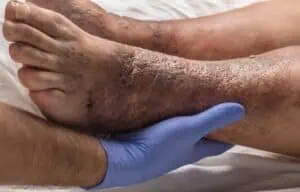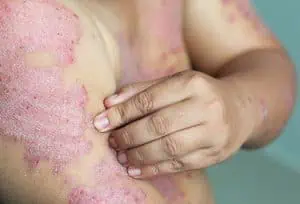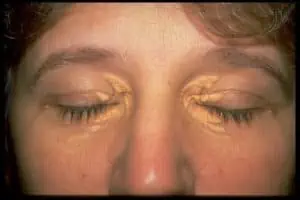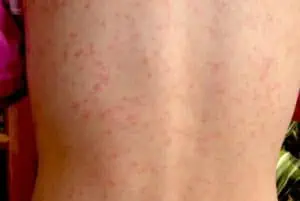Heart Disease And Your Skin Health

Heart disease is the leading cause of death in the United States and globally.
February is American Heart Month, and while many of us are focusing on buying sugary treats in heart shaped boxes to give family and friends, this is the perfect time to raise awareness about heart disease and how to recognize symptoms that would prompt you to see a cardiologist. We asked Fallon Beyer, PA-C, who practices in our St. Petersburg and Clearwater offices to weigh in on the correlation between heart and skin health.
“Cardiovascular disease can affect many parts of the body including the skin. Oftentimes your dermatologist is the first provider to pick up on signs of a heart condition, as many patients are unaware of the connection between the skin and heart”, says Fallon.
Here are 5 Skin Warning Signs of Heart Disease:
1. Skin discoloration, thickening and swelling of the lower legs
Stasis dermatitis is commonly seen in the dermatology office. This condition is due to venous insufficiency. This means the heart is not working properly because the valves in the leg veins are malfunctioning causing backflow of blood in the lower legs. This leads to fluid accumulation and swelling.
Symptoms of stasis dermatitis include: red dry itchy skin, shiny swollen skin, red ulcers that ooze, in severe cases the lower legs become so swollen and ulcerated infection occurs.
2. Red, scaly patches of skin
Psoriasis is a chronic immune mediated inflammatory disease that causes red scaly patches on the skin due to rapid skin cell turnover. Psoriasis, like other autoimmune diseases, can cause over activation of the immune system leading to inflammation in the body.
There are several different types of psoriasis but plaque psoriasis is the most common. Generalized plaque psoriasis typically affects the arms, elbows, knees, trunk and scalp. Symptoms include burning, itching, dry, flaky or scaly red patches of skin.
Individuals with psoriasis are at an elevated risk of developing other serious health conditions including heart disease. According to the National Psoriasis Foundation, people with severe psoriasis are 58% more likely to have a major cardiac event and 43% more likely to have a stroke. It is imperative to manage psoriasis appropriately to help reduce the inflammation in the body. If you have psoriasis make sure to discuss treatment options with your dermatologist and make sure a primary care provider is monitoring your heart health.
3. Yellowish waxy bumps growing around your eyes
Xanthelasmas are yellow waxy plaques caused by an accumulation of lipids or fatty deposits in the skin and are commonly seen on the inner corners of the eyelids.
Half of people with xanthelasma have high cholesterol. Studies have shown that xanthelasma, with or without high cholesterol, are a risk factor for atherosclerotic disease. Atherosclerotic disease is the build up and hardening of cholesterol and fats in the blood vessel walls causing obstruction of blood flow. People who have xanthelasma need to be evaluated for high cholesterol and managed appropriately by their primary care provider.
Xanthelasmas are asymptomatic but are frequently seen in the dermatology office for evaluation and treatment due to cosmetic concerns.
4. Multiple yellow-orange raised bumps on the body
Eruptive Xanthomas are yellow-orange papules that appear suddenly on the body. They are lipid (fat) deposits in the skin that commonly occur on the arms, legs, knees, elbows and buttocks. Eruptive xanthomas occur due to high levels of triglycerides. If left untreated, this can lead to serious health conditions such as coronary artery disease. The lesions clear rapidly once serum lipid levels are lowered. If a patient has this condition it is essential for them to have lab work for serum lipoprotein levels and aggressive treatment of elevated triglycerides to reduce their risk of heart disease.
Xanthomas are generally asymptomatic but may be encountered first in the dermatology office because they can look like a rash or bumpy growths called molluscum contagiosum.
5. Red blotchy pinpoint rash that feels like sandpaper
Scarlet fever is a contagious bacterial illness most commonly caused by strep throat. The bacteria, group A Streptococcus, produces a toxin that is responsible for the rash and systemic symptoms. Scarlet fever is accompanied by a sore throat and high fever. It is most common in children ages 5-15 and prior to antibiotic therapy was considered a very serious illness. If left untreated, Scarlet fever can progress to more serious health conditions such as Rheumatic heart disease, which can cause permanent damage to the valves of the heart.
Symptoms of Scarlet fever include: a red pinpoint rash that begins about the neck and face that feels like sandpaper and spreads within 48 hours to the trunk and extremities. Red lines are seen accentuating skin folds such as the groin, armpits and neck. The face can be flushed with pallor around the mouth and the tongue becomes red and bumpy (strawberry tongue).
If your child has strep throat or Scarlet fever it is very important to treat the condition with oral antibiotics to prevent the progression to more serious health concerns. Either penicillin or amoxicillin are the recommended first line of treatment.
If you see any of these above skin signs please make an appointment with your primary care provider. Education is key to preventing and treating heart disease.
References:
- https://www.aad.org/
- https://www.psoriasis.org/
- https://www.ncbi.nlm.nih.gov/pmc/articles/PMC3030216/
- https://www.mayoclinic.org
- https://www.medicalnewstoday.com/articles/322896.php
- https://www.medicinenet.com/psoriasis/article.htm
- https://emedicine.medscape.com/article/1213423-overview
- https://www.healthline.com/health/eruptive-xanthomatosis#pictures
- https://www.medicalnewstoday.com/articles/176242.php







